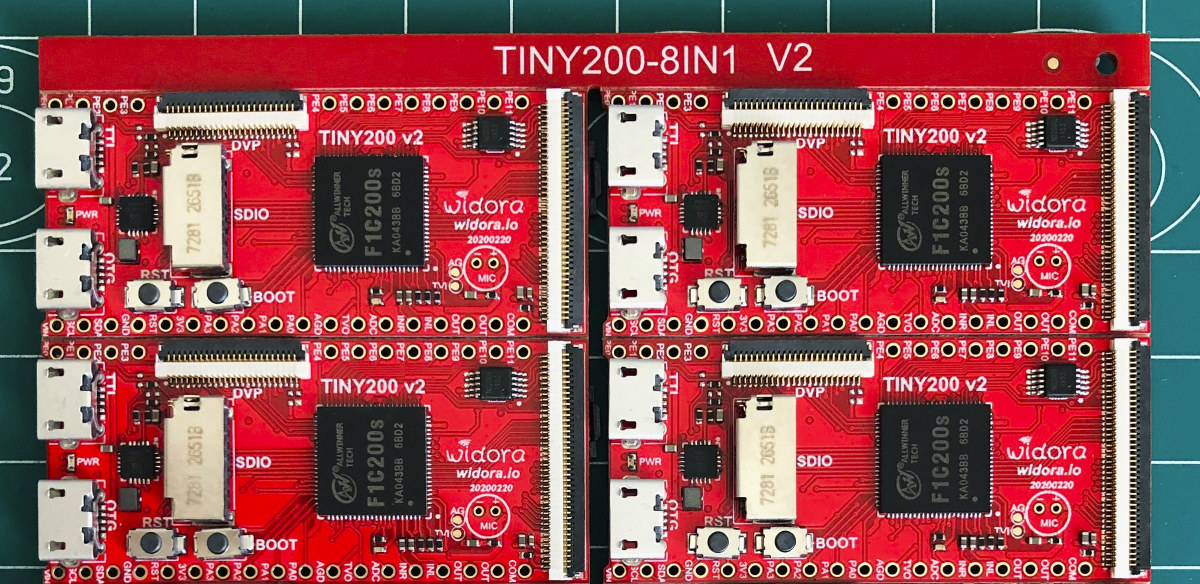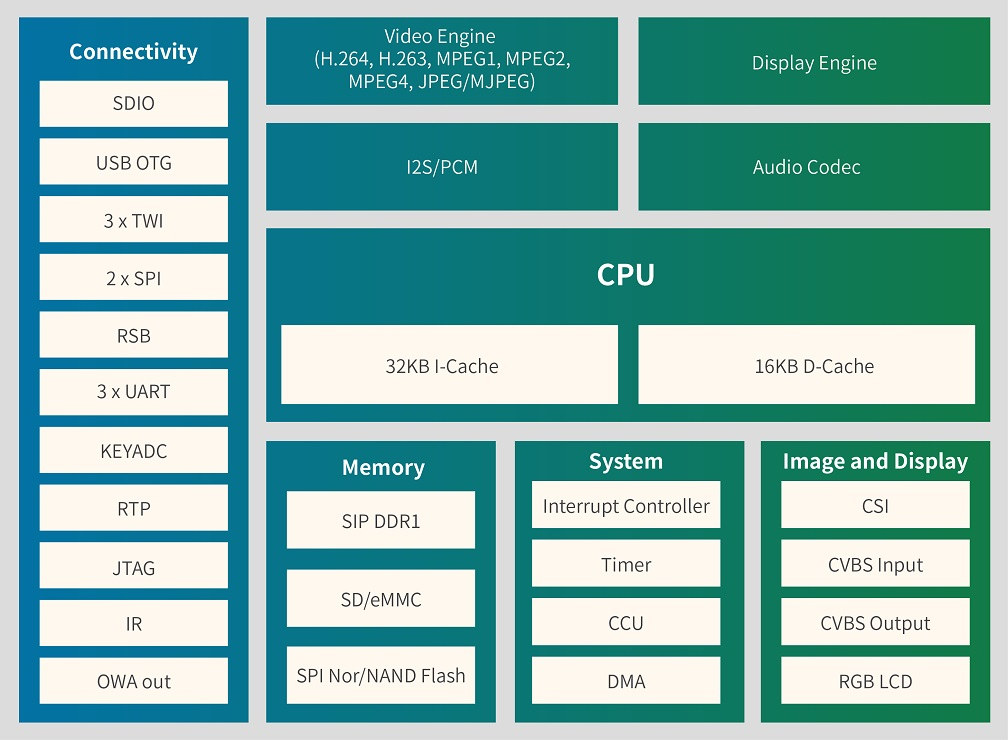Widora TINY200 is a tiny ARM9 development board equipped with Allwinner F1C200s with a DVP camera interface compatible with OV2640 / 5640 sensor, an audio amplifier, and various storage options from a 16MB SPI flash to a 512MB SD NAND flash.
I first heard about the processor when I wrote about Microchip SAM9X60 ARM9 SoC last month, and some people noted there were other fairly new ARM9 SoCs around such as Allwinner F1C200s that also includes 64MB RAM so you can run Linux without having to connect external memory chips.

Widora TINY200 V2 specifications:
- SoC – Allwinner F1C200s ARM926EJS processor @ 400-600 MHz (Overclockable to 900 MHz) with 64MB DDR1 RAM
- Storage – 16MB SPI NOR flash or 128MB NAND flash and MicroSD card slot or 512MB SD NAND flash.
- Display I/F – 40-pin RGB FPC cable for resistive touch screens; additional 6-pin FPC cable for capacitive touch support
- Camera I/F – 24-pin DVP interface
- Audio – Onboard microphone; Class D audio amplifier
- Connectivity – Optional WiFi via TF-WiFi card (MicroSD WiFi card)
- USB – 1x Micro USB OTG port also supporting FEL flash mode
- Debugging – Micro USB port connected to CP2104 USB-TTL serial controller
- Expansion – 30 through holes on the sides of the board for various I/Os
- Misc – BOOT & reset buttons
- Dimensions – 50.8 * 22.86mm

Note that’s the second revision of TINY200 board, and items highlighted in bold are new features added to the new revision. Two optional displays are offered by the company: a 480 x 272 resistive touch screen, and a 7″ 1024 x 600 capacitive touch screen.
The Wiki (link not working anymore) has information about the hardware (schematics, PCB layout), and a tarball with a Linux demo… Most information is in Chinese however. It should be noted that F1C200s processor is pin-to-pin and software compatible with F1C100s processor found in George Hilliard’s Linux business card. George tried the new processor on his card as it indeed works as a drop-in replacement. You’ll also find F1C200s datasheet and user manual at the end of his post as Allwinner sent him those documents but somehow did not think it would be a good idea to provide those resources on the company’s website… Linux 5.2.2 source code can be found on Github.
Widora TINY200 is available for purchase on Yoycart for $13.14 to $27.20 depending on storage configuration. If you prefer to purchase on Taobao the board is available for 50 to 113 RMB.

Jean-Luc started CNX Software in 2010 as a part-time endeavor, before quitting his job as a software engineering manager, and starting to write daily news, and reviews full time later in 2011.
Support CNX Software! Donate via cryptocurrencies, become a Patron on Patreon, or purchase goods on Amazon or Aliexpress





These ones look nice and in some aspects remind me about my LinuxStamp which was really awesome. However I’m a bit concerned about ARMv5. I was recently told its support is being dropped from FreeBSD. Even if that doesn’t necessarily mean the same will happen any time soon in Linux, it at least indicates a lack of interest from developers and likely a not so great support soon. I’m wondering if in the same size and budget it’s not possible to find ARMv7 in the form of Cortex A5/A7/A8, or even a more recent A32/A35.
> I’m wondering if in the same size and budget it’s not possible to find ARMv7
You can do a maker friendly (no bgas) Cortex A7 board based on a similar camera SoC for $10 – $15 even without ordering in multiples of 10,000.
sochip S3L(1*cortex a7 sip 128MB ddr3) or X3(4*cortex a7 sip 128MB/512MB ddr3) ?
No.. those are BGA. Once you’re doing BGA you might as well just use any of the cheap ARM SoCs and external memory. I try to avoid doxxing myself but what the hell I guess.. Here’s one I made earlier -> https://github.com/breadbee/breadbee
V3s 1.2GHz with 64MB ddr2 inside
100mbps net-link
usb otg
audio dac/adc
rgb/csi-mipi
the price is about $3.5
It has all of that stuff. The problem with the V3s is that it’s a massive QFP which is very easy to mess up and once you put your kernel etc onto SPI NOR you no longer have SPI you can use.
The current generation of these chips also has a CEVA XM6 co processor in there.
I would stick with the S3 because of mainline kernel support. Everything on the S3 is supported in mainline except for MIPI sensors, h.264 encode and the ISP. There is work going to to support these last bits. Allwinner has made a gigantic mistake by not participating in mainline and we’ll see over time if that ends up destroying their company. For sure lack of decent kernel support has cost Allwinner many millions of sales in the US and EU. It is a shame that Allwinner doesn’t understand that participating in mainline benefits them. Instead they fork and work in solitude turning every chip into a dead end.
In terms of Chinese vendor cooperation right now I’d say Rockchip is the best, but Rockchip does not have an offering comparable to the S3. Rockchip factory engineers are active in mainlining their kernel code and they even respond to bug reports. I really like the RK1808 but it is over $10 and it needs external DRAM. S3L is extremely cheap, around $3.50 for Q1000. Plus the onchip DDR3 eliminates the need for the high speed DRAM bus lines on the PCB. The added features of the RK1808 don’t justify paying 4X the price of the S3L.
dgp, I see your MSC313E board but MStar is even worse to work with than Allwinner. I view mainline kernel support as being far more critical than solderability. There are dozens of PCB houses that will solder BGAs on for few dollars. Currently we are using Elecrow, in the past we have used four other shops.
Note that Allwinner has use the same basic core for video encode/decode on all of their chips. Once a driver is figured out for one (like h.264 decode) it does not take long before all Allwinner chips are supported. So when h.264 encode is sorted out for the S3 it should also work on the H6, A10, A33, etc.
Sometimes Allwinner can be really stupid. The kernel in the V3/S3 SDK pre-dates Bluetooth Low Energy. Not being able to use BLE with the V3/S3 eliminates it from many IOT designs.
>dgp, I see your MSC313E board but MStar is even worse to work with than Allwinner.
It runs 5.6 already. A first round of patches to start mainline support were sent a few months ago. A revised v2 with support for almost all of their current chips will be going out next week..
The MIPI display interface is almost exactly the same as the mediatek one that’s already in kernel, ethernet works with a small patch to add a custom read/write method, usb is the same deal as the ethernet and so on.
>I view mainline kernel support as being far more critical than solderability.
Lots of people care about being able to solder things. Especially in the “I want to make one of these” maker segment.
So I can run the h.264 encoder using 5.6 on the MSC313E?
Those patches went out on LKML? I just searched and don’t see much from MStar. I see your stuff, but nothing from the factory.
[PATCH 1/4] dt-bindings: arm: Initial MStar vendor prefixes and compatible string
All of these camera chips pretty useless if the h.264 encoder can’t be used.
>So I can run the h.264 encoder using 5.6 on the MSC313E?
Not yet as I don’t need it but source of the vendor drivers etc is out there including a very recent 4.9 kernel that I put up last week. If someone wanted to sponsor doing that work it should be possible (even more so now that the freeelectrons guys did a lot of the structural work to get the sunxi stuff in).
Anyhow not everyone wants that stuff.. many people just want a chip that can run linux and they can use on cheap 2 or 4 layer boards.
>Those patches went out on LKML? I just searched and don’t see much from MStar.
That would be because I submitted them and mstar doesn’t exist anymore. Anyhow the initial “enough for a busybox shell” patches are here -> https://lkml.org/lkml/2019/10/14/51
The great thing about ARM v7 is that it’s actually possible to get it to boot to a shell without any specific mach stuff.
>All of these camera chips pretty useless if the h.264 encoder can’t be used.
Useless to *you*. Willy was saying it would be nice if there was something like this but based on a v7 ARM core instead. And I pointed out that there is. I didn’t say it’s a complete solution for whatever commercial project you’re working on. I’m really more interested in getting mario running via a nes emulator on this bad boy to be honest -> http://linux-chenxing.org/mercury5/cheapiemirrordashcam/
The thing I am very annoyed is that allwinner doesn’t like open source.
https://github.com/widora/S3-S3L-R11-V3s
The wafers of these chips are the same
I think S3L is the best chip, if you also like bga package.
mangogeek, how about a R329 dev board from Widora? If not, can you access the SDK and post it somewhere?
Maybe the Lichee Pi Zero folk might do a new board ?
I haven’t paid attention to the R329 chip, but I know that the R328 is used as a smart speaker.
Ok i will ask.
Did Allwinner release a new SDK with the F1C200 or is it still the ancient kernel 3.10 from the F2C100?
That link to 5.2.2 appears to be sunxi code? If so it is missing encoder support since there is no open source encoder support for any Allwinner CPU.
I have seen that there should be codec support in tina(buildroot or openwrt), but allwinner only provides .o libraries.
buildroot-tiny200 support (99%full feature): https://github.com/aodzip/buildroot-tiny200
Working & Tested
Boot Device:
U-Boot Driver:
Linux Driver:
Should working && Not tested
U-Boot Driver:
Linux Driver:
Work-In-Progress && Partially working
Linux Driver:
Unsupported… below and not mentioned devices.
Linux Driver:
The board is now also sold as MongoPi-R3 on DFRobot.
Expensive in Australia
core-electronics.com.au/mongopi-r3-development-board.html
$36.43 AUD